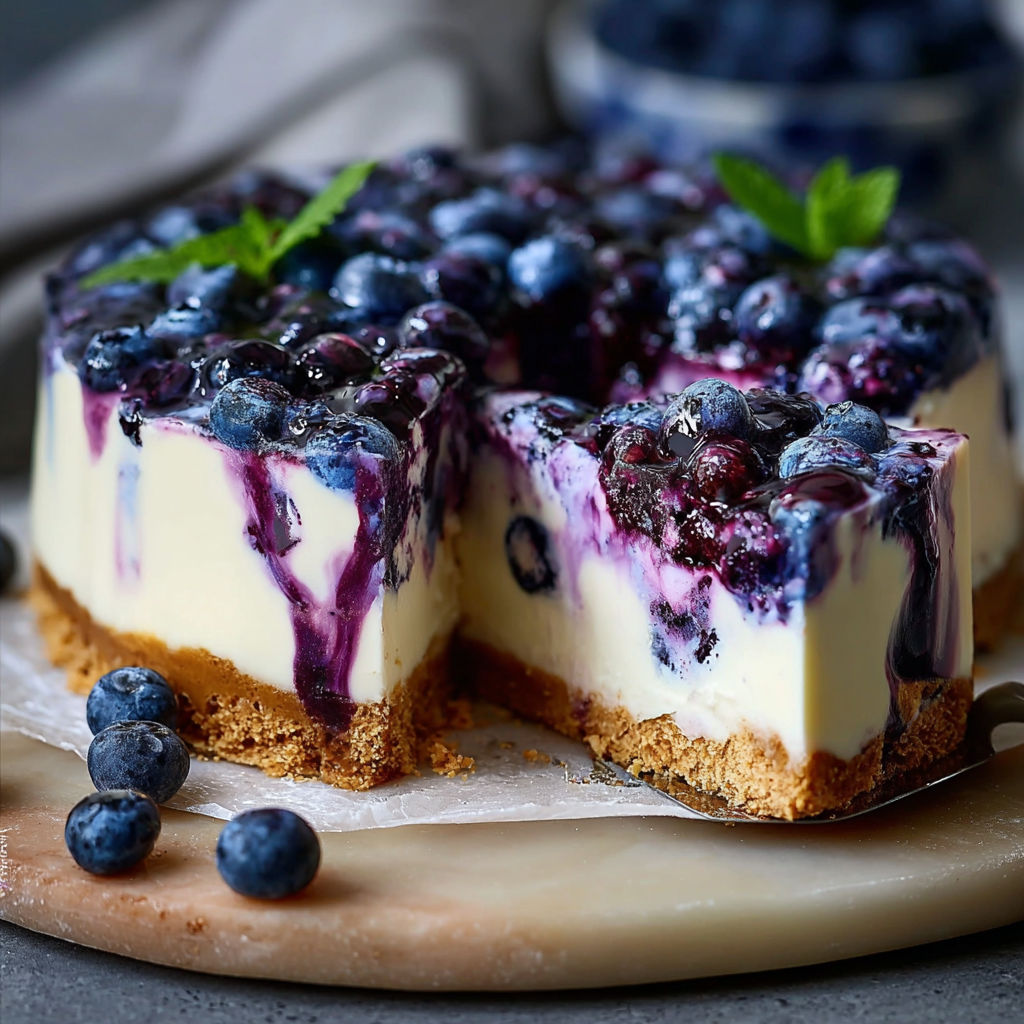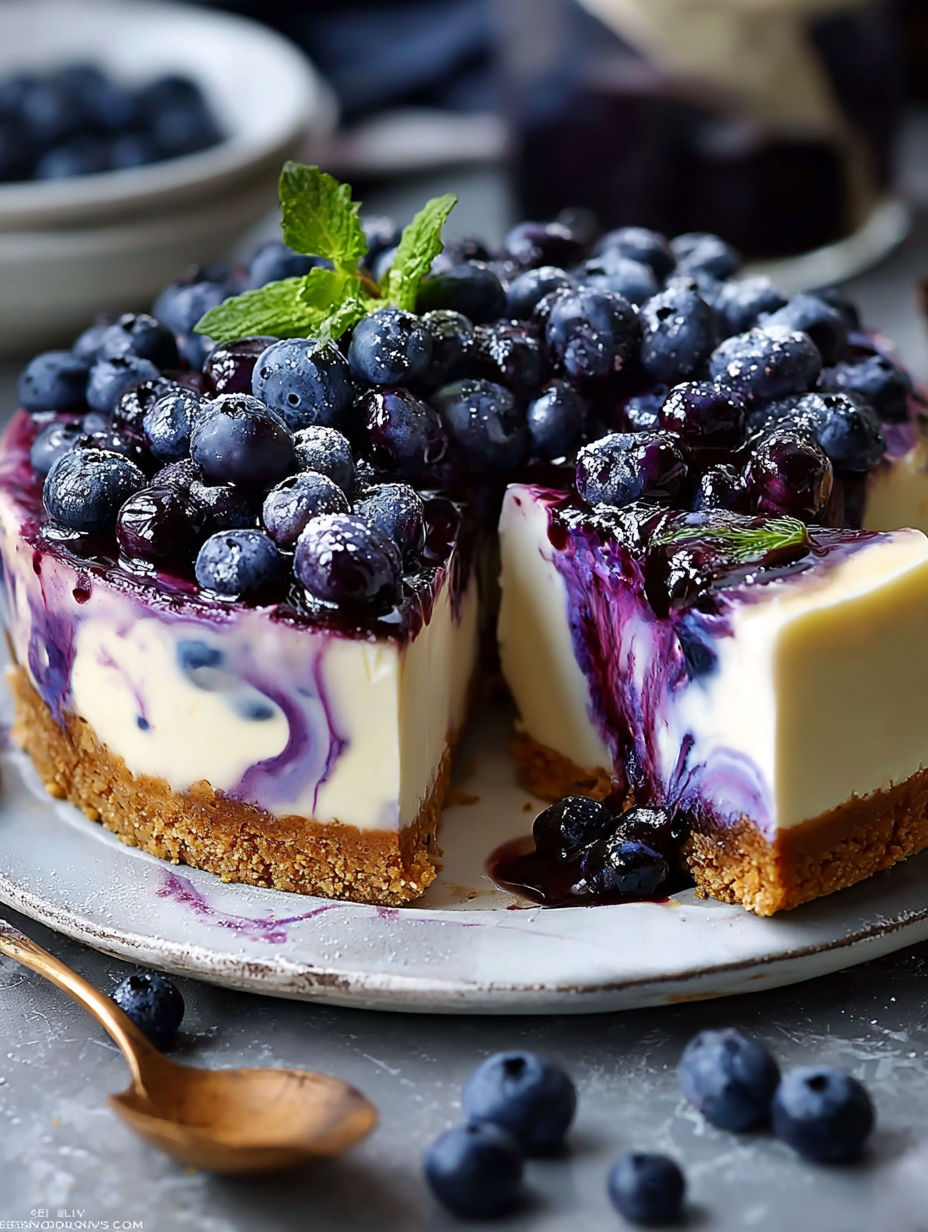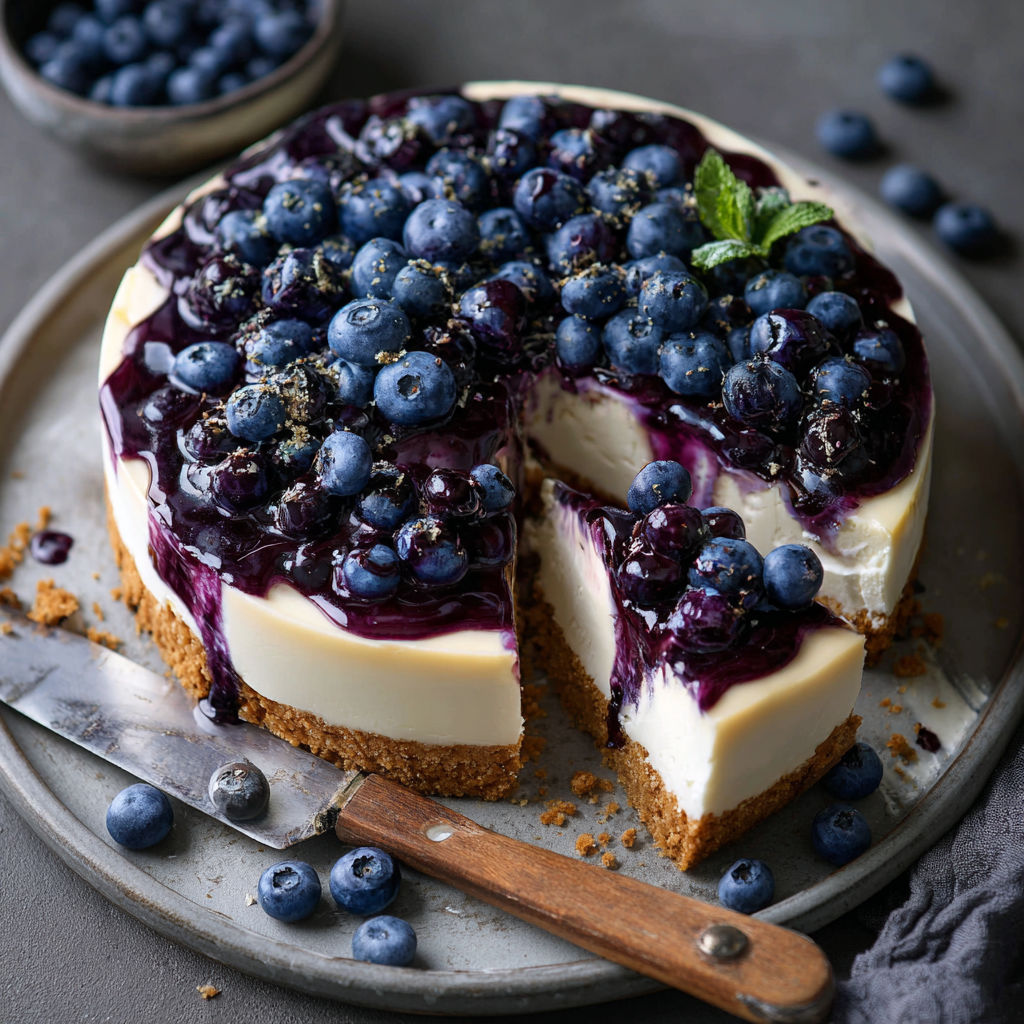 Pin
Pin
This silky blueberry cheesecake balances tangy cream cheese with sweet bursts of blueberries and a buttery biscuit base. The contrast between the creamy filling and fresh blueberry sauce creates a dessert that looks as impressive as it tastes.
I first made this cheesecake for my sister's birthday when she requested something different from the usual chocolate cake. The way her eyes lit up with that first bite convinced me this recipe needed to become part of our family tradition.
- Digestive biscuits or graham crackers form a buttery base that perfectly complements the creamy filling
- Full fat cream cheese is non negotiable for the right texture look for Philadelphia or another quality brand
- Greek yogurt adds tanginess and creates a lighter texture than using all cream cheese
- Cornstarch prevents cracks by stabilizing the eggs during baking
- Fresh blueberries work best for both the filling and sauce frozen can work in a pinch but drain thoroughly first
- Lemon zest brightens all the flavors without making the cheesecake taste lemony
- Vanilla bean paste gives richer flavor than extract the tiny specks look beautiful in the creamy filling
How To Make Easy Blueberry Cheesecake
- Prepare the crust
- Crush digestive biscuits into fine crumbs using a food processor for the most uniform texture. Mix thoroughly with melted butter until the mixture resembles wet sand. Press firmly into your springform pan using the bottom of a measuring cup to create an even compact layer. Baking the crust beforehand ensures it stays crisp beneath the filling.
- Mix the filling
- Ensure all refrigerated ingredients reach room temperature before beginning this creates the silkiest texture. Beat cream cheese and yogurt on medium speed until completely smooth with no lumps about 2 minutes. Scrape down the sides frequently. Add sugar cornstarch and zest mixing until just combined.
- Add eggs properly
- Add eggs one at a time on low speed mixing just until each disappears. Overbeating introduces air which causes cracks. Use a gentle folding motion when incorporating the blueberries to maintain their shape.
- Perfect the bake
- A low and slow bake at 285°F prevents cracks and ensures even cooking. The cheesecake is done when the edges are set but the center still has a slight wobble like firm jello. Cooling gradually in the turned off oven prevents dramatic temperature changes that cause cracks.
- Create the sauce
- Cook blueberries until they burst releasing their juices. Straining creates a smooth sauce while reducing intensifies flavor. Combining both the smooth sauce and whole berries gives the perfect texture contrast.
The first time I served this at a dinner party one guest who claimed to hate cheesecake took a polite bite then immediately asked for the recipe. The combination of the tangy cream cheese with sweet juicy blueberries converted him instantly. Now whenever blueberries are in season this is the first recipe I reach for.
Storage Tips
A properly stored cheesecake maintains its quality for up to 5 days in the refrigerator. Keep it in the springform pan until ready to serve covering with plastic wrap after it has completely cooled. For the freshest taste add the blueberry sauce just before serving rather than letting it sit for days. If freezing wrap individual slices tightly in plastic wrap then foil and thaw overnight in the refrigerator for portion control.
Seasonal Variations
While blueberries create the classic version this versatile cheesecake base works beautifully with other fruits. In summer replace blueberries with strawberries or raspberries. Fall calls for spiced apples or poached pears. Winter citrus particularly blood oranges creates a stunning variation. The technique remains the same just swap the fruit and adjust the sauce sweetness accordingly.

Troubleshooting Common Issues
Even experienced bakers occasionally encounter cheesecake challenges. If your filling seems too thin check that your cream cheese was at room temperature before mixing. For a cracked top next time lower your oven temperature further and ensure you're not overmixing after adding eggs. A sunken middle indicates underbaking give it an extra 5 10 minutes next time. Remember that even imperfect cheesecakes taste delicious and a strategic placement of blueberry sauce can hide many flaws.

Recipe FAQs
- → Can I use frozen blueberries instead of fresh ones?
Yes, frozen blueberries work well in both the filling and sauce. For the filling, add them frozen (don't thaw first) to prevent bleeding. For the sauce, you may need to cook them slightly longer, but they'll release plenty of juice.
- → How can I prevent my cheesecake from cracking?
The low baking temperature (285°F) helps prevent cracks, along with cooling in the oven with the door ajar. Don't overmix after adding eggs, and make sure all ingredients are at room temperature before starting.
- → Can this cheesecake be made in advance?
Absolutely! This cheesecake actually improves with time. Make it 1-2 days before serving and keep refrigerated. Add the blueberry sauce topping within a few hours of serving for the best presentation.
- → What can I substitute for digestive biscuits?
Graham crackers work perfectly as mentioned in the ingredients. You could also use vanilla wafers, shortbread cookies, or gingersnaps for different flavor profiles in the crust.
- → How do I know when my cheesecake is done baking?
The cheesecake is ready when the edges are set but the center still has a slight jiggle (like Jell-O). It will continue to set as it cools. If you're uncertain, an internal temperature of 150°F indicates it's done.
- → Can I make this without cornstarch?
The cornstarch helps stabilize the cheesecake and prevent cracks. You can substitute with 1 tablespoon of all-purpose flour or omit it entirely, though the texture may be slightly different.
